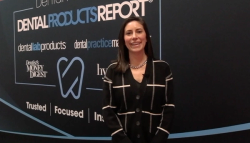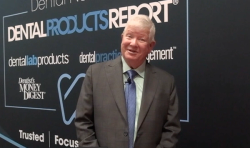Don't miss this video discussion about BurButler bur blocks between DPR Chief Clinical Editor John Flucke, DDS, and Steiriliu co-founder and BurButler inventor Paul Moore, DBA.
- About Us
- Advertise
- Editorial
- Contact Us
- Terms and Conditions
- Privacy Policy
- Do Not Sell My Personal Information
© 2025 MJH Life Sciences™ and Dental Products Report. All rights reserved.
Novel Organization Systems Drive Operatory Efficiency
Steiriliu is designing seemingly simple solutions that enhance organization and streamline workflows for everything including restorative cases, implant cases, and orthodontics.
For more than 10 years, Paul Moore, BDA; Hazel Hendy, MBA; and Steiriliu—the company they created—have focused on the little things that make dentists’ lives easier and more efficient. Their products include the BurButler for organizing and sterilizing dental burs, the LaminateButler for sterilizing and presenting restorative components chairside, the BlockButler for visual storage and stock control of chairside CAD/CAM block inventory, and 3D Deep Heat Seal Autoclave Pouches for effective, efficient sterilization pouching of taller items.
Paul and Hazel have twice won Practice of the Year at the Irish Dentistry Awards, and with 9 children and 8 grandchildren life is never dull. For them, innovation is a matter of survival.
Their motivation is to improve dental systems, protocols, and efficiencies. The focus is on creating tools for use in time-saving processes, as well as analyzing and streamlining workflows and handling, reducing waste, and improving sterilization standards.
What Does It Take to Innovate?
Innovation, design, production, and commercialization require a different level of commitment, courage, and tenacity. It is a long journey from concept to market, and not one for the fainthearted.
Creation of a concept starts by exploring the aims, benefits, features, and design needed to create something to solve the challenge at hand. Manufacturers are then engaged to explore material options, refine detailed drawings, and define production costs for prototypes, tooling, and units.
Detailed market assessments are essential. Discussions with patent attorneys to explore intellectual property rights will be needed to protect your investment of time, effort, and money.
Additionally, medical device registration and regulatory bodies must be involved. There are also marketing, sales, and distribution considerations. Will you sell directly online? Will you attend and support conferences to reach your market? Will you engage with distributors? There are numerous details to be sorted out when creating something new for the dental industry.
One of Moore’s and Hendy’s latest products, the EndoButler, is designed to simplify managing endodontic files during root canal treatments. During a root canal, the EndoButler allows the operator to focus on the tooth instead of the tools being used. Other systems in which endodontic files are stored on a ring force clinicians to shift their attention during the process. EndoButler keeps all files organized in a freestanding unit, making it easier for the dental assistant during treatment.
If the files are kept on a ring on the dentist’s finger, periodic shifting of attention is necessary. The EndoButler allows the assistant to help in this area of the process.
Assembling the instrumentation for a 21-mm, 25-mm, or 30-mm preparation on the EndoButler permits selection of access rotaries, hand files, engine files, working length ruler, recessed end-stopped measuring columns for setting the working length of the chosen files for cleaning and shaping, and a single-use open cell foam—all from one device. Even the final obturation can be determined with confidence using the “end-stopped” measuring columns.
The office can have 1 or 2 EndoButlers set up for the various lengths, with files pouched, sterilized, and ready for use.
“One of our prime ambitions was to reduce waste and carbon footprint. Any instruments used can be placed in the foam and disposed of as required after each visit. These can be replaced prior to processing, but any instruments unused can be left in situ. This way the clinician can have access to the full set of instruments they might require but only dispose of those they use,” Dr Moore says.
Creating the LaminateButler
When asked to create an organizer for orthodontic components, Dr Moore and Hendy considered how dentists organize and present all those small “bits” for chairside delivery of orthodontic cases, crown and bridge cases, and dental implant cases. They asked themselves how to make this a more efficient, controlled process.
Typically, when a dentist has several components needed to complete a case, they are often arranged on a piece of paper on a tray. These might be crowns, veneers, inlays, implant components, or other small items needed for a restoration. This system works well until the piece of paper is jostled. Then all the restorative parts would be in disarray. When these materials are no longer organized, it can take extra time to find the right piece for the right step of the clinical workflow, decreasing efficiency. If this happens during placement, it is a challenge to overcome.
Dr Moore and Hendy determined their solution would need to offer many features to provide clinicians with the benefits they need while working with restorations, orthodontics, implants, and other complex cases.
- The solution needed to include a tray that was autoclavable, with a cover that was also autoclavable but allowing steam penetration without compromising dust and aerosol protection.
- The tray needed wells to safely hold the separate components for each tooth to be restored.
- The wells in the tray should be large enough to hold an abutment, a screw, and a crown so the system could be used when restoring dental implants.
- Each well should be shaped to allow clinicians to easily remove the components with gloved fingers.
- There should be larger wells to hold bridges, drivers, or other instruments, materials, or components that are larger than an individual crown.
- The color of the tray should allow contrast for visualization.
- There should be a numerical system to identify each well to increase the level of organization and allow enhanced clinical communication.
The prototype for the LaminateButler made its debut at the International Dental Show 2019 in Cologne, Germany. Early reaction made it obvious to Dr Moore and Hendy that they had found a simple, elegant solution. They said every clinician who saw the LaminateButler instantly understood what it was, how it worked, and how it could help.
The LaminateButler is designed to provide a waterproof tray that organizes all parts, tools, and instruments, and eliminates confusion during treatment. When restoring the upper teeth, the curve of the tray is kept toward the patient and the natural teeth all correlate to the arch of the tray. For the lower teeth, the arch is away from the patient. This way the symmetry of the arch matches that of the teeth being restored.
Implant laboratory work can be taken off the model on return from the technician and can be kept organized by individual tooth while the components are autoclaved prior to placement.
The LaminateButler’s silicon construction offers durability, ease of cleaning, and a soft, nonsliding touch. The tray can be used as a color palette for stain and glaze systems, and the cover can help reduce dehydration of the stains.
With both solutions, as well as the company’s other products such as the BurButler silicone bur block, Steiriliu is focused on making clinicians’ jobs less complex when it comes to managing instruments in the operatory and the sterilization center.

 Download Issue: Dental Products Report January 2022
Download Issue: Dental Products Report January 2022

